Digitize it, automate it, electrify it, communicate with it, analyze it.
Siemens CEO of Siemens US Judy Marks announced the company’s new push to advanced manufacturing with Innovation Day, a day of presentations and demonstrations of the company’s technologies. She reminded the audience that Siemens is also an American company having made over $10 billion in investment in U.S. companies since 2007 and culminating with the company’s latest acquisition of Mentor Graphics of Oregon. She said “the heart of the software digital economy is right here in the U.S.”
The message from Siemens is that there is plenty of room for growth in the ongoing push to extend digitalization and tremendous opportunity for the U.S. to regain leadership in manufacturing.
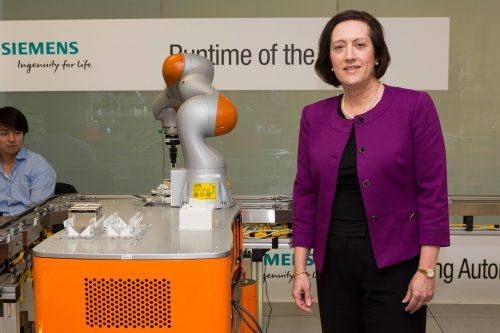
Marks presented the astounding figure that half of all the data in the world was created last year, but only 0.5 percent of it has been analyzed or used.
In addition, Siemens released the results of a study Siemens conducted among 290 U.S. companies entitled “The Race to a Digital Future.” The study found that even when data was analyzed the time to actionable information was often a matter of days. This isn’t exactly what we’ve been led to expect from the IoT revolution.
In 2015 Siemens introduced MindSphere, its operating system for the IoT; it has been developing in collaboration with partners and customers including IBM Watson to enable the development of customized apps. Like PTC, Siemens insists the Internet of Things will require an open ecosystem which will allow the creation of customized APIs.
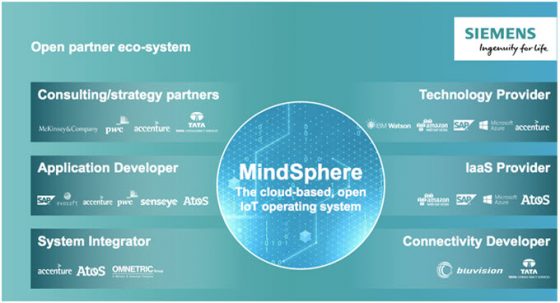
Siemens CTO Roland Busch says Siemens has explored the potential of IoT by connecting its own huge base of devices and assets. “We have a huge installed base,” says Busch. As a result he says, Siemens is able to differentiate and exploit its role as both consumer and vendor in some industries. MindSphere is complemented with Siemens’ service and cyber security offerings.
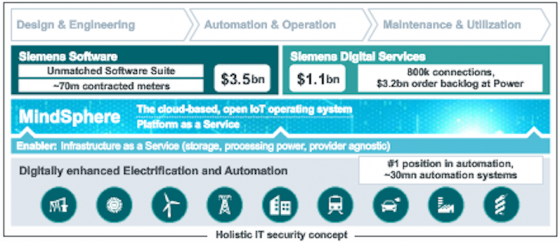
At the company’s Innovation Day, Busch outlined Siemens’ plans to focus on investment and R&D in specific areas where Siemens already has active interests including:
Distributed electrification: Siemens sees a move away from centralized energy providers, to more distributed systems, microgrids, which can harness energy from a variety of sources including renewables in a distributed fashion which makes it more resistant to black outs, disaster, and overload. Internally, Siemens says it will cut its own emissions in half by 2020 and be carbon neutral by 2030.
Blockchains: Blockchains are best known as the enabling technology beneath Bitcoin and other distributed financial systems. Blockchains are a method of storing and validating data without the need for centralized monitoring. They rely on cryptography and distributed storage to eliminate the possibility of manipulation and use authentication processes to guarantee confidentiality of user data. Beyond financial transactions, Blockchains can be used for any distributed systems, for contracts between machines and humans, and especially for systems too large to ever manage centrally, such as the Internet of Things. At PTC’s LiveWorx, researcher George Howard talked about how Blockchains can be used to set up agreed upon interactions for anything and information, payment, etc. is exchanged according to the rules. Siemens has been experimenting with blockchains to build a MicroGrid in Brooklyn in conjunction with Brooklyn-based energy startup LO3. In that case, they’re using blockchains to enable peer to peer energy transactions including the ability for people with renewable energy like solar panels to exchange energy resources. Now Siemens is alert to new opportunities to using blockchains in distributed systems.
Autonomous machines: Robots are long established as complements to humans in factories but machine learning, machine vision, AI, etc. are all leading to an age of machines that don’t require constant programming but can rather respond to requirements and situations and make their decisions. Siemens uses their spiderbots as an example of the type of machine that can work autonomously. Siemens researcher Sinan Bank created the bots with the ability to print a “web” of material in a swarm of other bots or alone. The researchers were thinking about autonomous machines to work in hostile environments such as colonizing the moon.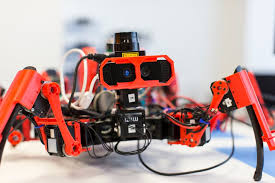
More down to earth, factories are already increasingly automated. Siemens sees that trend continuing as part of the IoT in which machines not only work unattended but can self-correct, update themselves, and even improve operations on their own. One of the aspects of machine learning researchers have noted is that machines don’t like people – they have the ability to try out a multiple of options and may even try out completely different directions than a human one, perhaps leading to better options. There are definitely benefits to not knowing any better.
Connected e-mobility: As a major player in transportation including the design and manufacture of cars, mass transportation systems, etc. Siemens is exploring ways to improve transportation thinking about whole systems rather than individual vehicles. Obviously, vehicles are part of the IoT, and as they’re connected to cloud-based applications all means of transportation can be managed and optimized. Could we have universal mobility and no traffic?
AI: Siemens wants to remind the world that it has been active in AI and neural nets for 30 years and has around 50 key patents for learning systems. However, it seems the IoT, with the clouds of data emanating from all things, is going to drive AI faster and further than ever before. That’s not just Siemens that’s for everyone and it’s almost as if all those 30 years of development in the field are just prelude to what’s coming next. At Innovation Day, Siemens used the example of self-optimizing gas turbines, which are able to monitor their own operations and improve their operation to reduce emissions.
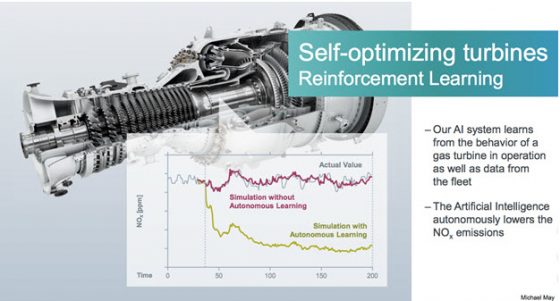
Next47
Internally Siemens is trying to foster its own start up mentality. In 2016, Siemens introduced its internal startup engine Next47, so named because Siemens was founded in 1847 and this effort is intended to help the company keep up with changes so it can lead for the next phase of the company’s life. Next47 is focusing on these five interconnected themes we’ve talked about: AI, Blockchains, distributed electrification, autonomous machines, connected e-mobility, and using this focus to search out and foster startups. Lak Ananth, manager of Next47 says they want to “unite the world of start-ups with the world of large companies.”
One of the groups’ first projects was a project developed with Airbus in April 2016 for the electrification of aviation. The companies plan to demonstrate the advantages of hybrid/electric propulsion systems for small planes and medium sized passenger aircraft by 2020.
The next47 group also exemplifies the company’s open innovation strategy in which the company encourages ideas from employees. And supports it with its Innovation Fund and it’s Quickstarter platform. Siemens is also collaborating with other companies, universities, other research organization, and leaders through the Siemens Technology and Innovation Council.
What do we think?
It seems as if human progress has two races going on. One towards an exponential advancement in technological improvement that can try and ameliorate the world’s problems such as global warming, better distribute resources, and enable more efficient manufacture to put production closer to consumption. The other towards utter self-destruction.
The industrial revolution did bring change and advancement; but it also ground up people in the gears of progress. We don’t know how we’re going to give people jobs or at least a sense of purpose as automation reduces the need for human labor. That seems like a problem we should be trying to figure out alongside the march to automated efficiency.





